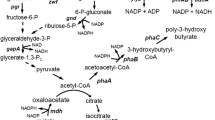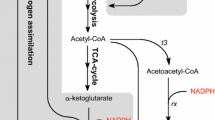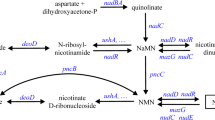Abstract
Two glucose dehydrogenase (E.C. 1.1.1.47) genes, gdh223 and gdh151, were cloned from Bacillus megaterium AS1.223 and AS1.151, and were inserted into pQE30 to construct the expression vectors, pQE30-gdh223 and pQE30-gdh151, respectively. The transformant Escherichia coli M15 with pQE30-gdh223 gave a much higher glucose dehydrogenase activity than that with the plasmid pQE30-gdh151. Thus it was used to optimize the expression of glucose dehydrogenase. An proximately tenfold increase in GDH activity was achieved by the optimization of culture and induction conditions, and the highest productivity of glucose dehydrogenase (58.7 U/ml) was attained. The recombinant glucose dehydrogenase produced by E. coli M15 (pQE30-gdh223) was then used to regenerate NADPH. NADPH was efficiently regenerated in vivo and in vitro when 0.1 M glucose was supplemented concomitantly in the reaction system. Finally, this coenzyme-regenerating system was coupled with a NADPH-dependent bioreduction for efficient synthesis of ethyl (R)-4-chloro-3-hydroxybutanoate from ethyl 4-chloro-3-oxobutanoate.






Similar content being viewed by others
References
Koeller KM, Wong CH (2001) Enzymes for Chemical synthesis. Nature 409:232–240
D’Arrigo P, Pedrocchi-Fantoni G, Servi S (1997) Old and new synthetic capacities of baker’s yeast. Adv Appl Microbiol 44:81–123
Schmid A, Dordick JS, Hauer B, Kiener A, Wubbolts M, Witholt B (2001) Industrial biocatalysis today and tomorrow. Nature 409:258–268
Ogawa J, Shimizu S (1999) Microbial enzymes: new industrial applications from traditional screening methods. Trends Biotechnol 17:13–21
Chartrain M, Greasham R, Moore J, Reider P, Robinson D, Buckland B (2001) Asymmetric bioreductions: application to the synthesis of pharmaceuticals. J Mol Catal B Enzym 11:503–512
Stewart JD (2000) Organic transformations catalyzed by engineered yeast cell and related systems. Curr Opin Biotechnol 11:363–368
Yadav JS, Nanda S, Thirupathi PR, Bhaskar AR (2002) Effcient enantioselective reduction of ketones with Daucus carota Root. J Org Chem 67:3900–3903
Ogawa J, Shimizu S (2001) Industrial microbial enzymes: their discovery by screening and use in large-scale production of useful chemicals in Japan. Curr Opin Biotechnol 13:367–375
Juan B, Juan P, Leticia GS (1999) Variations in the kinetic behaviour of the NADPH-production systems in different tissues of the trout when fed on an amino-acid-based diet at different frequencies. Int J Biochem Cell Biol 31:277–290
Baik SH, Ide T, Yoshida H, Kagami O, Harayama S (2003) Significantly enhanced stability of glucose dehydrogenase by directed evolution. Appl Microbiol Biotechnol 61:329–335
Inose K, Fujikawa M, Yaniazaki T, Kojima K, Sode K (2003) Cloning and expression of the gene encoding catalytic subunit of thermostable glucose dehydrogenase from Burkholderia cepacia in Escherichia coli. Bba-Proteins Proteom 1645:133–138
Kataoka M, Sri Rohani LP, Wada M, Kita K, Yanase H, Urabe I, Shimizu S (1998) Escherichia coli transformation expressing the glucose dehydrogenase gene from Bacillus megaterium as a cofactor regenerator in a chiral alcohol production system. Biosci Biotechnol Biochem 62:167–169
Jing KJ, Xu ZN, Liu Y, Jiang XX, Wang F, Peng L, Cen PL (2005) Efficient production of recombinant aldehyde reductase and its application for asymmetric reduction of ethyl 4-chloro-3-oxobutanoate to ethyl (R)-4-chloro-3- hydroxybutanoate. Prep Biochem Biotechnol 35:203–215
Sambrook J, Fritsch EF, Maniatis T (1989) Molecular cloning: a laboratory manual, 2nd edn. Cold Spring Harbor Laboratory Press, New York
Peng L, Xu ZN, Fang XM, Wang F, Cen PL (2004) High-level expression of soluble human β-defensin-2 in Escherichia coli. Process Biochem 39:2199–2205
Xu ZN, Liu G, Cen PL, Wong WKR (2000) Factors influencing secretive production of human epidermal growth factor (hEGF) with recombinant E.coli K12. Bioprocess Eng 23:669–674
Toshihide M, Reynaldo VE, Takako N, Yasutaka M, Seiji N, Itaru U, Hirosuke O (1990) Structure of isozyme gene of glucose dehydrogenase from Bacillus megaterium IAM1030. J Ferment Bioeng 70:363–369
Yamamoto K, Kurisu G, Kusunoki M, Tabata S, Urabe I, Shigeyoshi O (2001) Crystal structure of glucose dehydrogenase from Bacillus megaterium IWG3 at 1.7 Å resolution. J Biochem 129:303–312
Acknowledgments
We appreciate Dr. Liping Huang (Department of Chemical and Biomolecular Engineering, The Ohio State University, Columbus, OH, USA) for his critical review and helpful discussion.
Author information
Authors and Affiliations
Corresponding author
Rights and permissions
About this article
Cite this article
Xu, Z., Jing, K., Liu, Y. et al. High-level expression of recombinant glucose dehydrogenase and its application in NADPH regeneration. J Ind Microbiol Biotechnol 34, 83–90 (2007). https://doi.org/10.1007/s10295-006-0168-2
Received:
Accepted:
Published:
Issue Date:
DOI: https://doi.org/10.1007/s10295-006-0168-2




